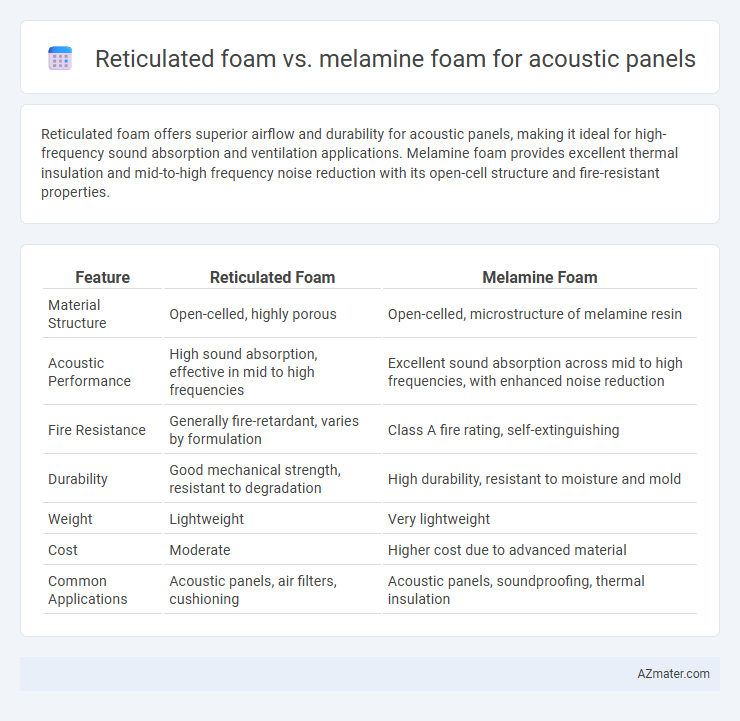Reticulated foam offers superior airflow and durability for acoustic panels, making it ideal for high-frequency sound absorption and ventilation applications. Melamine foam provides excellent thermal insulation and mid-to-high frequency noise reduction with its open-cell structure and fire-resistant properties.
Table of Comparison
| Feature | Reticulated Foam | Melamine Foam |
|---|---|---|
| Material Structure | Open-celled, highly porous | Open-celled, microstructure of melamine resin |
| Acoustic Performance | High sound absorption, effective in mid to high frequencies | Excellent sound absorption across mid to high frequencies, with enhanced noise reduction |
| Fire Resistance | Generally fire-retardant, varies by formulation | Class A fire rating, self-extinguishing |
| Durability | Good mechanical strength, resistant to degradation | High durability, resistant to moisture and mold |
| Weight | Lightweight | Very lightweight |
| Cost | Moderate | Higher cost due to advanced material |
| Common Applications | Acoustic panels, air filters, cushioning | Acoustic panels, soundproofing, thermal insulation |
Introduction to Acoustic Panels: Reticulated vs Melamine Foam
Reticulated foam offers an open-cell structure with high porosity, enabling superior sound absorption by trapping and dissipating acoustic energy effectively. Melamine foam features a rigid, lightweight structure with excellent thermal resistance and soundproofing qualities, making it ideal for reducing noise reflections in acoustic panels. Acoustic panels using reticulated foam provide enhanced airflow and durability, while melamine foam panels excel in controlling mid to high-frequency noise with minimal material thickness.
Material Composition: Reticulated Foam Explained
Reticulated foam consists of a network of open-cell polyurethane or polyester, characterized by its high porosity and minimal cell membranes, which allows sound waves to pass through and dissipate effectively. Melamine foam, derived from a thermoset resin, features a unique microporous structure that provides excellent sound absorption while being lightweight and fire-resistant. The open-cell reticulation enhances airflow and sound diffusion, making reticulated foam ideal for applications requiring high breathability and noise reduction in acoustic panels.
Material Composition: What is Melamine Foam?
Melamine foam is a lightweight, open-cell material made from a thermosetting polymer derived from melamine resin, known for its excellent sound absorption and fire-resistant properties. Unlike reticulated foam, which features a skeletal structure with large voids, melamine foam has a fine, rigid microstructure that enhances sound attenuation across a broad frequency range. Its unique chemical composition and porous network make melamine foam particularly effective in acoustic panel applications where lightweight, durable, and fire-retardant materials are essential.
Acoustic Performance Comparison: Sound Absorption Capabilities
Reticulated foam offers superior sound absorption thanks to its open-cell structure that allows high-frequency noise to dissipate efficiently, making it ideal for applications requiring effective noise control. Melamine foam, while denser and fire-resistant, provides broad-spectrum sound absorption with better performance in mid to high frequencies but less airflow permeability. For acoustic panels, reticulated foam excels in environments prioritizing maximum sound absorption and ventilation, whereas melamine foam balances noise reduction with enhanced thermal and fire safety properties.
Durability and Lifespan: Which Foam Lasts Longer?
Reticulated foam offers higher durability due to its open-cell structure, which resists compression and maintains shape over time, making it suitable for long-term acoustic applications. Melamine foam, while effective in sound absorption, is more fragile and prone to crumbling under continuous mechanical stress, resulting in a shorter lifespan. For acoustic panels requiring prolonged use and resistance to wear, reticulated foam generally lasts longer than melamine foam.
Fire Resistance and Safety Standards
Reticulated foam offers excellent fire resistance due to its open-cell structure, making it suitable for environments requiring compliance with stringent safety standards such as ASTM E84 Class A fire ratings. Melamine foam, known for its inherent flame retardant properties and high thermal stability, often surpasses other materials by easily meeting UL 94 V-0 and EN 13501-1 certifications. Both foams contribute effectively to acoustic panel safety, but melamine foam provides superior combustion performance and smoke suppression critical for fire-sensitive applications.
Moisture and Chemical Resistance Analysis
Reticulated foam exhibits superior moisture resistance due to its open-cell structure, allowing for quick drying and preventing mold growth, making it ideal for humid environments. Melamine foam offers high chemical resistance, effectively withstanding exposure to a wide range of solvents and cleaners without degradation. Combining reticulated foam's moisture resilience with melamine foam's chemical stability provides optimized durability for acoustic panels in challenging conditions.
Installation and Handling Differences
Reticulated foam offers a more open-cell structure, making it lighter and easier to cut and shape during installation compared to the denser Melamine foam, which requires more careful handling due to its brittle nature. Melamine foam panels often need precise adhesive application to avoid damage, while reticulated foam can typically be mounted with a wider range of fasteners or adhesives. The flexibility of reticulated foam allows for quicker installation in complex acoustic designs, whereas melamine foam's rigid form provides consistent acoustic performance but demands more cautious handling to prevent cracking.
Cost Efficiency: Reticulated vs Melamine Foam
Reticulated foam offers superior cost efficiency for acoustic panels due to its lower manufacturing costs and durability, making it ideal for large-scale sound absorption projects. Melamine foam, while providing excellent acoustic performance and fire resistance, tends to be more expensive and less durable, increasing long-term replacement costs. Choosing reticulated foam reduces initial investment and maintenance expenses without significantly compromising soundproofing effectiveness.
Recommended Applications and Use Cases
Reticulated foam is widely recommended for industrial and commercial acoustic panels due to its open-cell structure that ensures superior airflow and sound absorption, especially in HVAC systems, machinery enclosures, and noise control rooms. Melamine foam offers excellent noise reduction in office partitions, recording studios, and home theaters because of its lightweight, fire-resistant properties and effectiveness in absorbing mid to high-frequency sounds. Choosing between reticulated and melamine foam depends on specific application needs such as airflow requirements, fire safety standards, and target sound frequencies for optimal acoustic performance.

Infographic: Reticulated foam vs Melamine foam for Acoustic panel
 azmater.com
azmater.com